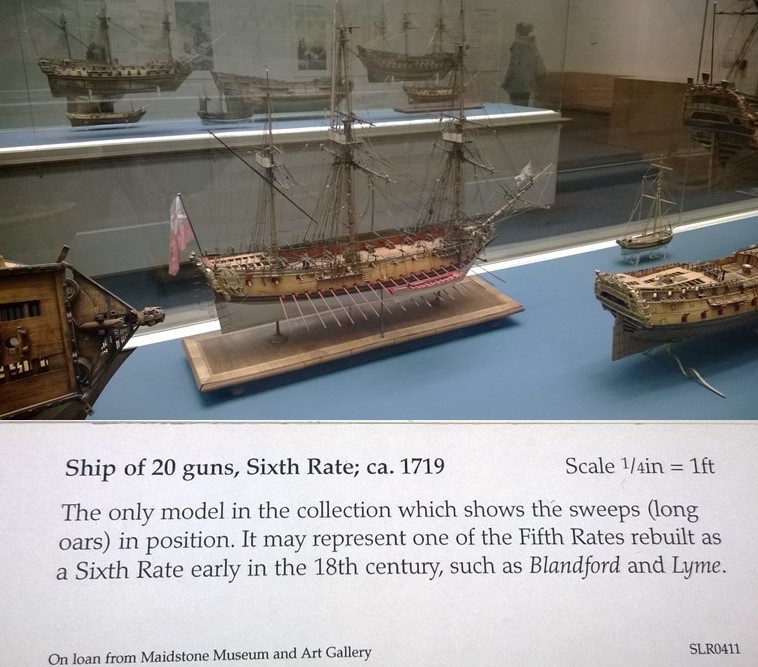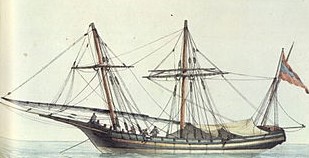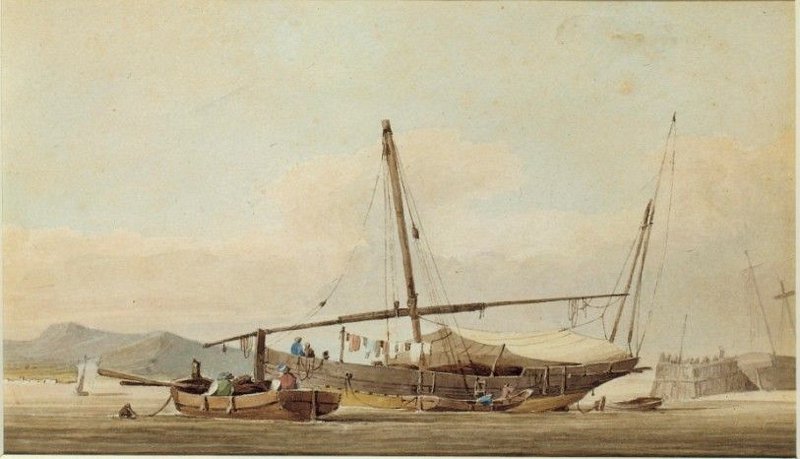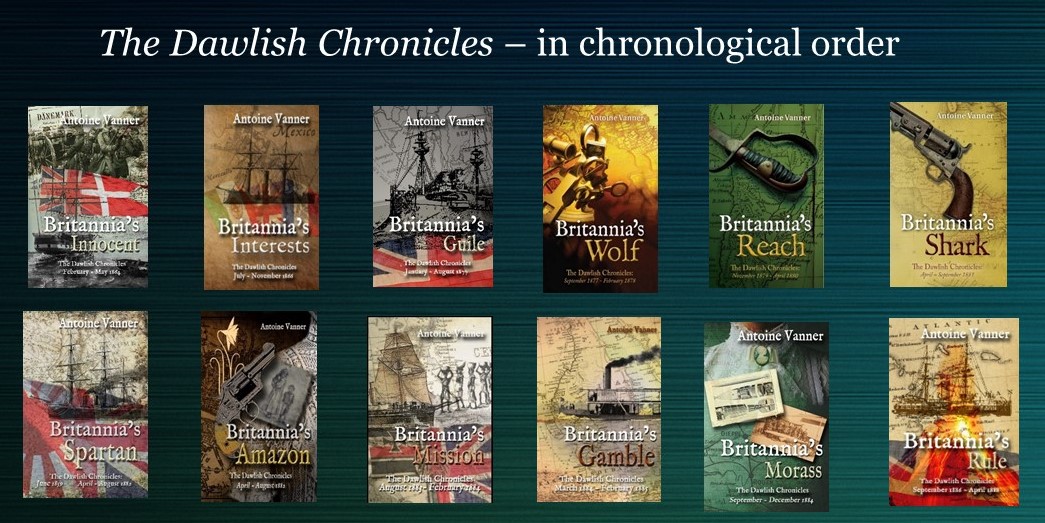HMS Pulteney and the Spanish Xebecs, 1743
There have been many blogs on this site dealing with actions in the Age of Fighting Sail that involved only a few vessels, in many cases two only. In most cases, skilful manoeuvring and sail management, taking full advantage of wind and sea conditions, were key factors in positioning vessels to deliver their broadsides from the most advantageous position. There can only have been few cases in which the action took place in a calm and the movements of sailing warships were determined by the ability of their crews to propel them by sweeps or oars. Sweeps were long oars which could be extended out through gun ports and their use seems to have fallen away in the course of the 18th Century. In Britain’s National Maritime Museum in Greenwich, there is only one model of a vessel with sweeps deployed, as shown, with its caption, in the photograph below.

It was during the War of Austrian Succession in January 1743 that HMS Pulteney fought a battle in the Straits of Gibraltar in which her sweeps, and her enemies’, were to determine the course of action. HMS Pulteney, “a large brigantine” carrying 16 carriage guns (I can find no further detail) and commanded by a Captain James Purcell, had been cruising in the Straits to deter Spanish naval movements (as was the case in most in 18th Century wars, Spain was allied with France against Britain). She now, however, found herself becalmed off the British fortifications at Gibraltar and under observation from Spanish forces at Algeciras, directly across the bay from them.
 The Xebec configuration was popular in the Mediterranean – here is a Greek-Ottoman example by Antoine Roux (1765 – 1835)
The Xebec configuration was popular in the Mediterranean – here is a Greek-Ottoman example by Antoine Roux (1765 – 1835)
Two Spanish xebecs now left Algeciras to intercept Pulteney. Xebecs were a type of craft common in the Mediterranean and were employed by the Spanish and French navies as well as by North African corsairs. Light and highly manoeuvrable, many were essentially galleys, with provisions as a matter of course for oar propulsion as well as by large lateen sails. (Sentencing to galley service was a dreaded punishment for criminals). This contrasted with the use of sweeps, which were usually employed as a last resort, and operated by members of the crew. The two xebecs that came out to confront Purcell and HMS Pulteney were each crewed by 120 men and each carried 12 guns, apparently 9-pounders. Their rowers’ efforts were supplemented by the current through the Straits running in their favour. HMSPulteney, by contrast, had only 42 men on board, three of whom had been wounded in an earlier action.
 Xebecs in action five years before the Pulteney’s encounter: “Antonio Barceló’s Xebec Facing two Algerian Corsair Galiots, 1738”. By Ángel Cortellini y Sánchez (1858-1912).
Xebecs in action five years before the Pulteney’s encounter: “Antonio Barceló’s Xebec Facing two Algerian Corsair Galiots, 1738”. By Ángel Cortellini y Sánchez (1858-1912).
The xebecs opened fire with individual guns as they approached but when within hailing distance called on Captain Purcell by name to strike so as to avoid unnecessary slaughter. He and the Spanish captains appear to have known each other – this being an era of gentlemanly warfare and courteous respect for the enemy. Purcell, as was probably expected, refused to yield and the engagement commenced, HMS Pulteney being at a disadvantage to her more manoeuvrable foes. Gunfire was exchanged for an hour and three quarters and the Spanish xebecs made three separate attempts to board. Given how small Purcell’s crew was it is improbable that all 16 of HMS Pulteney’s guns could have been manned but they at last inflicted sufficient damage to the xebecs that they broke off the action to head for home. Even now, HMS Pulteney attempted to chase them, propelled by her sweeps since there was still no wind. The lighter xebecs managed however to make their escape.
 A xebec at anchor, by Thomas Richard Underwood (1772-1836)
A xebec at anchor, by Thomas Richard Underwood (1772-1836)
HMS Pulteney had suffered seriously, her sails and rigging completely destroyed and her hull and masts damaged. The action had occurred in full view of the Gibraltar garrison and boats went out to tow her back to safety. Her crew had suffered one dead and five seriously wounded but it was reported afterwards that the clothes of every man on board had been rent by shot or fragments. A subscription was raised by Gibraltar’s governor, officers and merchants to present Purcell with a piece of plate while money was distributed to the crew. Purcell’s and HMS Pulteney’s heroic stand was the type of incident that was to inspire so much naval fiction in later years.
Do you read naval fiction?
You may enjoy Britannia’s Gamble
1884 – fanatical rebels, the ISIS of their day, are sweeping all before them in the vast wastes of the Sudan and establishing a rule of persecution and terror. Only the city of Khartoum holds out, its defence masterminded by a British national hero, General Charles Gordon. His position is weakening by the day and a relief force, crawling up the River Nile from Egypt, may not reach him in time to avert disaster.
But there is one other way of reaching Gordon…
A boyhood memory leaves the ambitious Royal Navy officer Nicholas Dawlish no option but to attempt it. The obstacles are daunting – barren mountains and parched deserts, tribal rivalries and merciless enemies – and this even before reaching the river that is key to the mission. Dawlish knows that every mile will be contested and that the siege at Khartoum is quickly moving towards its bloody climax.
Outnumbered and isolated, with only ingenuity, courage and fierce allies to sustain them, with safety in Egypt far beyond the Nile’s raging cataracts, Dawlish and his mixed force face brutal conflict on land and water as the Sudan descends into ever-worsening savagery.
And for Dawlish himself, one unexpected and tragic event will change his life forever.
Britannia’s Gamble is a desperate one. The stakes are high, the odds heavily loaded against success. Has Dawlish accepted a mission that can only fail – and worse?
Click Below for details:
For United States For Canada For UK & Ireland For Australia & New Zealand
The Dawlish Chronicles – now up to twelve volumes, and counting …
Available in paperback and Kindle. Subscribers to Kindle Unlimited read all at no extra charge. Click on the banner above for details of the individual books.
Six free short stories are available for download to your Kindle. Access them by registering for the Dawlish Chronicles mailing list – just click on the banner below. You’ll be kept updated on new books and will receive other free stories at intervals.



